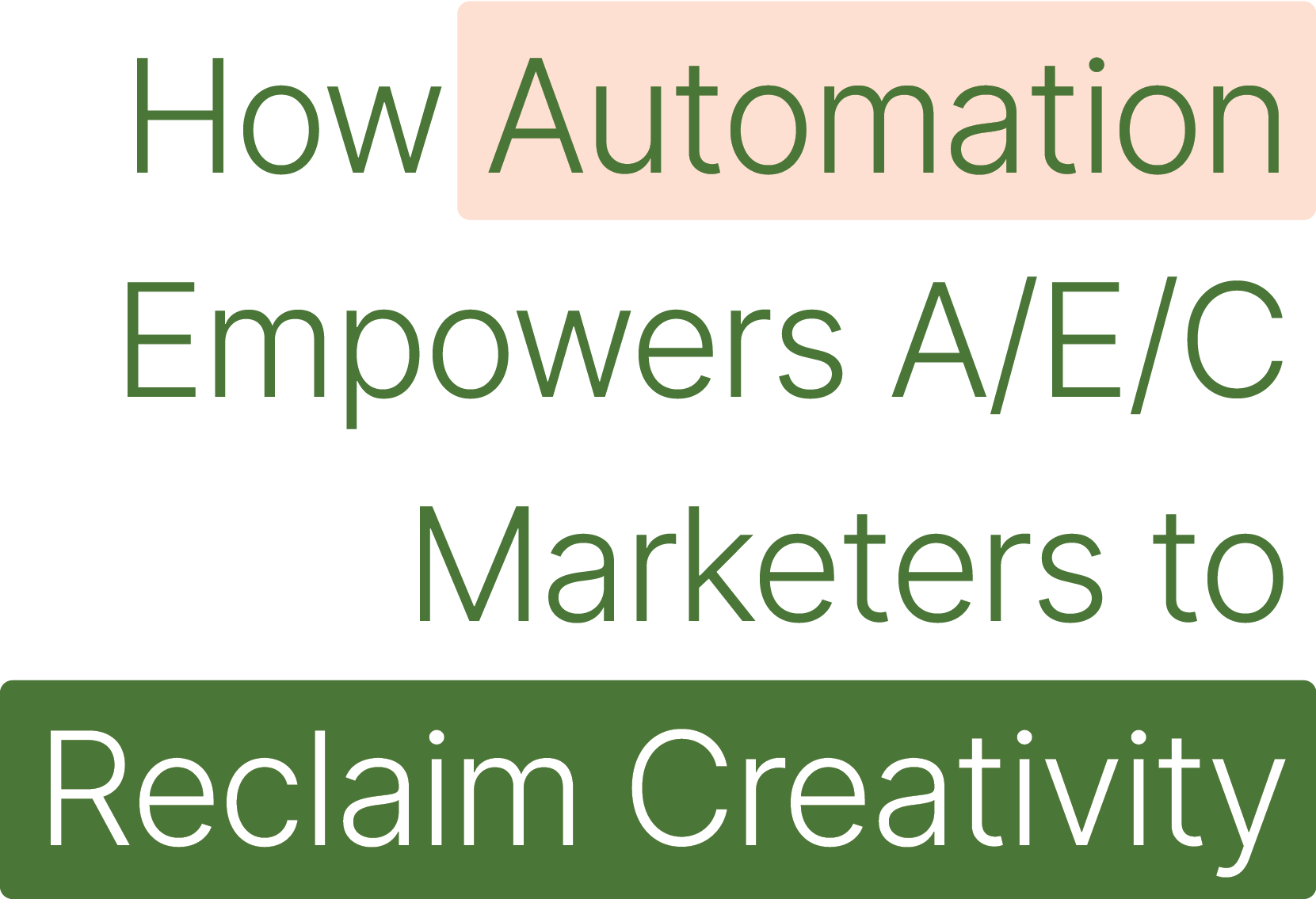



About

IN EVERY ISSUE
1.
PRESIDENT'S MESSAGE
Why Cultivating Value Matters

2.
Publisher's Message
Creativity, Authenticity, and the Power of Standing Out

3.
FROM THE EDITOR
Welcome to the January/February 2025 Issue of the Marketer

Calendar of Events
4.

The Architecture, Engineering, and Construction (A/E/C) industries thrive on creativity and problem-solving, yet creative pursuits often take a backseat for many A/E/C marketers. Endless to-do lists filled with administrative tasks, proposal deadlines, and client communications leave little room for the imaginative work that drives impactful campaigns and winning strategies.
This is where marketing automation tools come in. Embracing marketing automation and streamlined workflows can help marketers claim time to focus on high-value, creative projects to connect with clients, communicate a firm’s value, and set their firms apart in a crowded marketplace.
What Are the Benefits of Creativity in A/E/C Marketing?
1. Craft Memorable and Compelling Proposals
Originality is vital to successful A/E/C proposals—one of the final steps to securing new business. Creative proposals don’t just list qualifications; they tell a story.
Fresh thinking in proposals can take many forms, such as presenting data from a new perspective, crafting a compelling narrative, or including storytelling elements. A captivating title, a meaningful quote, a relatable story, or even a well-timed joke can bring originality and flair to your proposal.
People love stories. It’s how we connect on an emotional
level with the client and differentiate from the competition.
Remember that your people have stories, like the unique paths that led them to their current roles, and your projects have stories, like the challenges your team faced and overcame or the inspiration behind a design element.”
—Rachelle Ray, Head of AEC Marketing Innovation, OpenAsset
2. Build Stronger Client Connections
Innovative marketing is key to establishing deeper relationships with clients. Using data-driven insights allows marketers to creatively tailor campaigns to specific client needs and preferences. Personalization, whether in email campaigns, social media ads, or content, makes clients feel valued and understood.
Personalization in your proposals can also go a long way. For example, including project examples that mirror the client’s vision, such as past work in their industry or projects of similar scale, builds credibility and relevance. Highlighting key insights gained from conversations with the client—such as addressing specific pain points or incorporating their sustainability goals—reinforces trust and attentiveness. These touches make your submission more engaging and help establish a stronger connection with the client.
3. Standing Out in a Crowded Market
Differentiation is critical in the A/E/C industries, and inspired marketing is the ultimate competitive advantage. Marketing teams that prioritize imaginative campaigns, branding, and content can distinguish their firms from competitors offering similar services.
According to Loopio.com, on average, organizations respond to 65% of the RFPs their company receives—meaning most teams deem two-thirds of bids worth answering. How can you make yours stand out from the other respondents? Creativity.
While an inspired approach alone may not guarantee selection, it plays a significant role in making your proposal stand out in a crowded field of submissions. To stand out and win more bids, it’s not about submitting more proposals; it’s about creating higher-quality proposals that are tailored, engaging, and impactful. This shows clients that your firm is capable and invested in delivering custom, innovative solutions.
Scenarios That Can Negatively Impact Creativity:
Overwhelming Workloads
Marketers in the A/E/C industries often juggle numerous responsibilities like proposal development, campaign management, client communications, and internal reporting, leaving little time for creative thinking.
Repetitive Administrative Tasks
Routine duties like asset retrieval, data entry, email campaign management, and scheduling consume valuable time that could be spent on high-impact, creative projects.
Tight Deadlines
The fast-paced nature of the A/E/C industries means marketers frequently work against the clock, prioritizing immediate deliverables over innovation or brainstorming.
Pressure for Efficiency
The demand to produce results quickly often shifts the focus from quality and originality to speed and volume, stifling opportunities for creativity.
Resource Constraints
Limited access to tools, technology, or dedicated team members can make it challenging for marketers to explore new approaches.
Lack of Strategic Focus
Constantly putting out fires and managing short-term tasks often prevents marketers from stepping back to think strategically or develop innovative campaigns.
Interruptions and Task Switching
Frequent interruptions, ad hoc requests, and switching between tasks make it difficult to achieve the deep focus needed for creative problem-solving.
Creativity Becoming Secondary
With the emphasis on operational efficiency and meeting deadlines, creativity often takes a backseat, leading to campaigns and proposals that lack originality or engagement.
These challenges highlight the need for solutions—like automation and improved workflow management—to give marketers room to prioritize creativity. Marketing automation offers a powerful solution by streamlining repetitive tasks and freeing time for engaging in creative activities.
How Marketing Automation Can Reclaim Creative Time
Creativity often feels like a luxury for A/E/C marketers overwhelmed by routine tasks and tight deadlines. Fortunately, the solution isn’t working harder or longer; it’s about working smarter. Here’s how marketing automation can help you reclaim creative time:
1. Improve Efficiency
Finding the right images and assets is a time-consuming part of proposal creation. Shockingly, in the State of Proposals in AEC Marketing Report, only 36% of respondents claimed they have a searchable, tagged database.
Marketing automation tools integrated with Digital Asset Management (DAM) systems make this process seamless by categorizing, tagging, and making assets searchable. This allows teams to quickly access on-brand, pre-approved visuals.
For example, Taylor Australia, a leading Australian construction firm, significantly improved its proposal workflows by implementing a DAM system. Previously, their team spent hours searching disorganized folders for project imagery. Now, with the right DAM software, they locate approved images within seconds, saving valuable time that can be focused on creative endeavors.
2. Increase Productivity
Automating workflows enables A/E/C marketing teams to handle larger volumes of work without increasing headcount. Teams can maintain efficiency even during peak workload periods by allowing automation tools to handle routine processes.
Marketing automation reduces the time spent on repetitive administrative tasks such as scheduling social media posts, sending follow-up emails, or managing data entry. Thus, marketers can reclaim valuable hours for more strategic and creative activities, such as brainstorming or developing compelling proposals.
3. Enhance Proposal Content
AI-powered tools are transforming proposal creation by assisting with sections like project descriptions, team bios, and scope summaries. The real value of AI lies in enhancing human input and helping marketers craft compelling narratives.
AI serves as an assistant, enabling teams to create richer content faster while focusing on strategic work. For example, AI can explore complex topics, such as the impact of healthcare design on patient well-being, providing a foundation that marketers can enrich with case studies and tailored content.
Marketers can also use AI to refine tone, language, and alignment with branding goals. However, when adopting AI, it’s essential to choose trusted, compliance-focused tools tailored to the A/E/C industry to ensure content quality and data security.
4. Maintain Brand Consistency
A DAM system is a centralized repository for all digital assets, including images, graphics, templates, and documents. Storing assets in a single, organized location means marketing teams can ensure that only the most current and approved materials are used across all client-facing communications.
This centralization prevents inconsistencies that can arise from outdated or unauthorized assets, thereby strengthening brand recognition and fostering trust with clients.
A DAM system helps firms create reusable proposal templates, embedding pre-approved brand elements and formatting. Marketers can quickly tailor these templates to specific projects without deviating from brand guidelines, ensuring a cohesive and professional proposal.
5. Facilitate Seamless Collaboration
Beyond brand consistency, DAM systems and other automation tools also enhance collaboration by providing shared access to assets and automating workflows across various departments, such as marketing, sales, and project management.
Integrating your automation tools with Customer Relationship Management (CRM) systems and specialized proposal management software further centralizes all proposal-related tasks. This integration allows marketers to focus on crafting compelling content rather than managing logistics.
Prioritize Creative Freedom With Automation
By embracing marketing automation, A/E/C firms empower their marketing teams to focus on what truly matters: crafting unique campaigns, developing winning proposals, and building deeper connections with clients. Automation streamlines repetitive tasks, minimizes errors, optimizes workflows, and delivers measurable ROI through cost efficiency and enhanced productivity.
When marketers are freed from administrative burdens, they can dedicate their energy to strategic and creative endeavors, leading to more impactful work and greater job satisfaction. Creativity is not just a competitive advantage—it’s the driving force behind innovation and meaningful client relationships.
Cinthya Soto is the SEO Content Writer at OpenAsset and holds a Master of Science in Digital Marketing from an international business school and a Bachelor of Arts in Psychology from the University of California, Santa Barbara. At OpenAsset, she specializes in creating engaging and strategic content that helps A/E/C professionals optimize their marketing efforts. With a passion for storytelling and a focus on driving results, Cinthya is dedicated to crafting valuable insights that empower A/E/C firms to streamline workflows and stand out in a competitive market.
Connect on Linkedin










